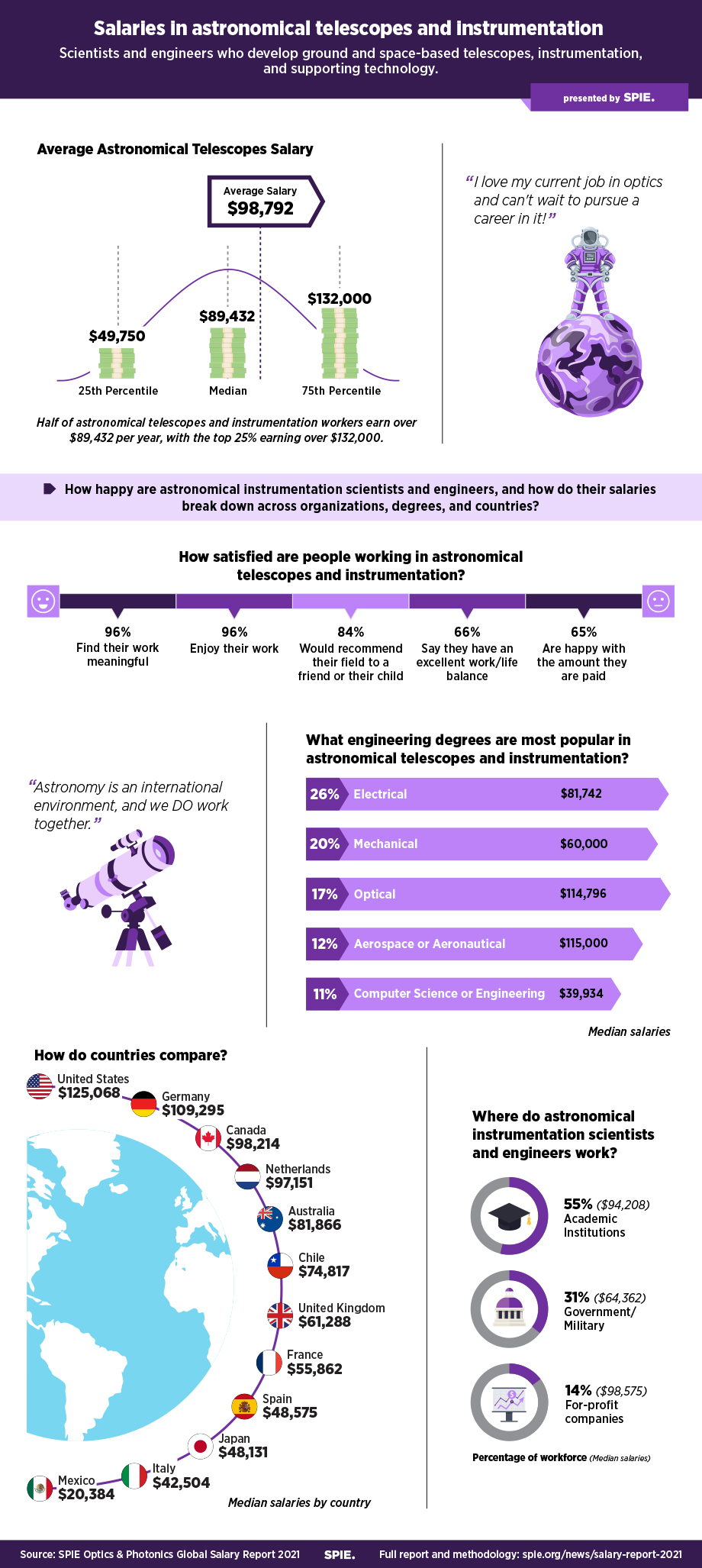Salaries in astronomical telescopes and instrumentation: Scientists and engineers who develop ground and space-based telescopes, instrumentation, and supporting technology
Astronomical telescopes and instrumentation salaries in optics and photonics
The opportunities and challenges of a growing field inspire the work of scientists and engineers specializing in astronomical, ground-based, space, and other telescopes. The average salary for this group was $98,792 worldwide in 2020. This table, and all other data on this page, come from the 2021 Optics and Photonics Global Salary Report.
| 25th Percentile | Median | 75th Percentile |
| $49,750 | $89,432 | $132,000 |
| 2020 salaries, N=284 |
What most inspired people to choose a career in optics and photonics?
Members of the astronomical telescopes and instrumentation community cite a variety of inspirations for choosing their career paths. The opportunity and excitement of a growing field tops the list, followed closely by scientific curiosity about light, and the influence of professors, teachers, and mentors.
| What most inspired you to pursue optics, photonics, or a related field? | Percentage |
| The opportunities, excitement, and challenges presented by a growing field | 21% |
| Scientific curiosity about light | 20% |
| Professors, teachers, or mentors | 18% |
| Other | 14% |
| A course at university | 13% |
| Interest in solving problems with light | 11% |
| A course at secondary school | 3% |
| 2020 Optics and Photonics Global Salary Report |
What are the most popular job roles and how much are they paid?
Just over one quarter of astronomical telescopes and instrumentation workers fill jobs in basic research of science, earning a median salary of $81,619. Those engaged in engineering or design earn a median salary of $85,000.
| Job Role | Percentage of Workers | Median Salary |
| Basic research or science | 26% | $81,619 |
| Engineering or design | 22% | $85,000 |
| Applied research | 11% | $81,717 |
| Project or program management | 10% | $115,258 |
| College professor, teacher, or other educator | 8% | $77,010 |
| Executive, leadership, or owner | 6% | $153,012 |
| Technical or lab | 5% | $71,000 |
| Other | 4% | $71,800 |
| Application or product development | 3% | $61,469 |
Are there gender differences in representation and pay?
Women survey respondents in the astronomical telescopes and instrumentation community earn 11% more on average their male counterparts, going against the pattern in the broader optics and photonics community, where men earn 28% more than women.
| Gender | Percentage of Workers | Median Salary |
| Women | 18% | $96,000 |
| Men | 82% | $85,929 |
Which countries have the highest salaries in astronomical telescopes and instrumentation?
The United States tops the list for salaries in astronomical telescopes and instrumentation, followed by Germany, Canada, and the Netherlands.
| Rank | Country | Median Salary |
| 1 | United States | $125,068 |
| 2 | Germany | $109,295 |
| 3 | Canada | $98,214 |
| 4 | Netherlands | $97,151 |
| 5 | Australia | $81,866 |
| 6 | Chile | $74,817 |
| 7 | United Kingdom | $61,288 |
| 8 | France | $55,862 |
| 9 | Spain | $48,575 |
| 10 | Japan | $48,131 |
| 11 | Italy | $42,504 |
| 12 | Mexico | $20,384 |
What’s the one job skill that workers would like to improve?
Survey takers were asked the question “If you could improve one job-related skill, which skill would you improve?” Technical skills and leadership/management abilities top the list.
| Job-related Skill Workers Would Most Like to Improve | Percentage |
| Technical skills (including math, coding, and analysis) | 24% |
| Leadership/management | 23% |
| Foreign language | 13% |
| Public speaking/presentation | 9% |
| Networking | 9% |
| Self-confidence | 8% |
| Writing | 8% |
| Interpersonal abilities | 4% |
| Other | 3% |
What kinds of engineering degrees are most popular?
About half of survey respondents are engineers (53%), trained in a variety of specialties.
| Type of Engineering Degree | Percentage of Workers | Median Salary |
| Electrical | 26% | $81,742 |
| Mechanical | 20% | $60,000 |
| Optical | 17% | $114,796 |
| Aerospace or aeronautical | 12% | $115,000 |
| Computer science or engineering | 11% | $39,934 |
| Engineering Physics | 7% | $65,577 |
| Software | 4% | $123,867 |
These results suggest that students interested in astronomical telescopes and instrumentation can choose from a variety of engineering disciplines and find a fit within this community, though optical engineering looks like the best path towards higher earnings.
For more information on optics and photonics salaries, plus details on methods and sampling, visit the 2021 SPIE Optics and Photonics Global Salary Report. To learn about your colleagues' views on scientific priorities, funding, and other topics, visit our article on the National Academies' Decadal Survey.
| Want to know more? Get similar news sent monthly to your inbox |
|




